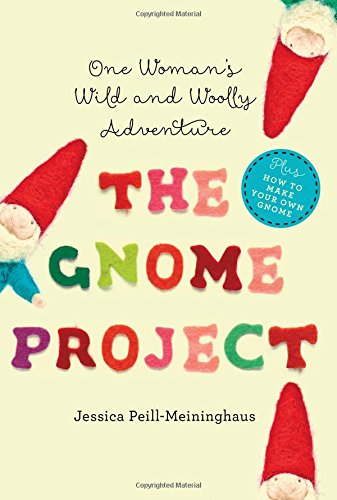[alert variation=”alert-info”]Publisher: Countryman Press
Formats: Hardcover, Kindle, eBook
Purchase: Powell’s | Amazon | IndieBound | Barnes & Noble | iBooks[/alert]
You may be thinking that a book about a woman who makes a felt gnome every day for a year would have a limited audience — aren’t there only so many gnomes a reader can take? But this book is not simply about crafting gnomes. It’s a manifesto about the importance of daily habits and their ability to motivate, and it holds a powerful message to creative people of all kinds: don’t wait for inspiration to come to you; just do it!
Jessica is an artist and crafter, making needle-felted paintings and miniatures: she uses a barbed needle to shape dyed wool into any shape imaginable. At the start of the book, she self-deprecatingly muses on her lack of follow through and her “museum of unfinished works,” a description which will surely make many artists smile with recognition. To motivate herself and cultivate her own stick-to-itiveness, she begins a daily practice: make one gnome every day, for a year. Bearded gnomes, baby gnomes, dark-skinned gnomes, female gnomes with braids, gnomes in a rainbow of colorful ensembles, even mer-gnomes with fish tails and seaweed in their beards.
During this practice, life doesn’t stand still. She and her family buy a house in Maine, rent out their home in Oregon, move across country, and try to adjust to their new location while renovating their run-down, old-but-new-to-them house. It’s exhausting just to read about, but although she sometimes falters in her daily gnome practice, she doesn’t give it up.
In addition to being a treatise on the power of habit and resilience to make one a better artist (or a more productive person in general), The Gnome Project is also a beautifully designed little book. Nearly every daily gnome has been lovingly photographed, waving from potted plants or meditating on rocks. Most pages have at least one gnome poking its head up from the margins (although in a couple cases, the pictures seemed to cut off text on the page). The lettering, layouts, and details of the pages are exquisite from a design standpoint. Even the soft, embossed cover of the book subtly recalls the texture of the gnomes. And if the gnomes appeal to you, there is, of course, a section in the back of the book with thorough instructions on how to make your own.
Making hundreds of tiny gnomes may not seem monumental, but to do anything every day for a year (and beyond!) is a big accomplishment. Jessica’s gnomes may not have changed the world, but that wasn’t the point; the point was to set out a goal and prove to herself that she could do it, as well as to grow:
“I had stayed with [the gnomes] through all of it, and, quite remarkably, I discovered that they had stayed with me. The gnomes gave me confidence…these gnomes gave me back to myself.”
The author makes it clear that she isn’t perfect and doesn’t possess any supernatural skill, which makes her achievements seem even more accessible to struggling artists and creatives who may be inspired by this book to start their own daily practice. The Gnome Project is the book equivalent of a supportive friend telling you, “whatever it is, you can do it.”
[signoff predefined=”Social Media Reminder” icon=”twitter”][/signoff]

